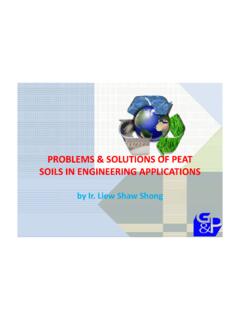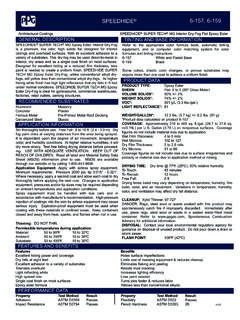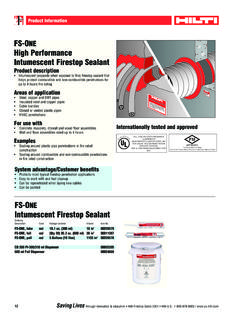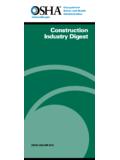Transcription of Design and Construction Considerations for Deep Basement
1 SSP Geotechnics Sdn Bhd Design and Construction Considerations for deep Excavation By: Gue & Tan September, 1998. Design AND Construction Considerations . FOR deep EXCAVATION. By: Gue & Tan SSP Geotechnics Sdn Bhd INTRODUCTION. In Malaysia, deep basements have been extensively constructed, especially in the last 5 years, to effectively utilise the underground space for car parks and other usage in the expensive and congested urban area. The deepest excavation for Basement that has been completed to date is and is in Kuala Lumpur. Lately, there were a number of failures of support system or retaining wall used for deep excavation.
2 The failures of the retaining wall or support system can be catastrophic affecting the serviceability of adjacent structures. This paper presents, in a selective way, the Design and Construction Considerations for deep excavation. The commonly occurred mistakes and carelessness are also highlighted. Finally a case history describing the influence of excavation on the surrounding structures is presented and discussed. Design Considerations . In this paper, the major Design Considerations for deep excavation is divided into five sections as follows : (a) Planning of subsurface investigation and laboratory testing.
3 (b) Evaluation of foundation of adjacent properties and their tolerances. (c) Selection of type of retaining wall. (d) Selection of type of support system. (e) Design of retaining wall. It is imperative that preliminary analyses be carried out for many options of the walls and support systems to assess on the cost and time of Construction together with the technical requirements on the safety and its influence on the adjacent structures before the selection on the final option to produce safe and economical Design . Page 1. SSP Geotechnics Sdn Bhd Design and Construction Considerations for deep Excavation By: Gue & Tan September, 1998.
4 PLANNING OF SUBSURFACE INVESTIGATION AND. LABORATORY TESTING. As stated in BS8002:1994 Code of practice for earth retaining structures , sufficient information should be obtained on the ground and ground water conditions together with the strength and deformation properties of the soils which will be retained and the soils which will support the earth retaining structures. Geological maps memoirs and handbooks should be consulted together with any other source of local knowledge. Proper planning and supervision of subsurface investigation ( ) and laboratory testing is utmost important for the designer to produce safe and economical Design for the deep Basement Construction .
5 For the selection of geotechnical parameters for Design of retaining walls, reference can be made to Gue (1997 & 1998) and CIRIA Report 104. (1984). Field Tests The code of practice for site investigation BS5930:1981 describes the general Considerations to be taken into account and details the methods of site investigation available. Generally, a number of boreholes should be adequate to establish the ground conditions along the length of the wall and to ascertain the variability in those conditions. Piezocone tests would complement the boreholes particularly in sedimentary loose or soft deposits.
6 For a large site, geophysical survey would be an advantage to optimise the subsurface investigation. Prior to planning of , it is important to acquire the geology formation of the site. The geological information of all states in Malaysia can be purchased from Geological Department of Malaysia. As recommended in BS8002:1994, the centres between boreholes will vary from site to site but should generally be at intervals of 10m to 50m along the length of the wall depending on the complexity of the geology, subsoil profile and adjacent structures. Some times, subsurface investigation outside the site should be carried out especially around the sensitive adjacent structures.
7 In addition, dilapidation survey of the adjacent structures should also be carried out as required by local authorities and assessment of the effect due to the deep excavation as described in details in Sections and respectively. In Malaysia, the most common field test carried out for Design of retaining wall comprises of rotary wash boring (borehole) and includes Standard Penetration Tests (SPT), Page 2. SSP Geotechnics Sdn Bhd Design and Construction Considerations for deep Excavation By: Gue & Tan September, 1998. Pressuremeter tests, collection of disturbed and undisturbed soil sampling for laboratory testing.
8 If the site is underlain by soft clayey material, field tests such as piezocone tests, in-situ penetrating vane or vane shear tests in the borehole are commonly required. The details on the selection of suitable field tests for various types of subsoil of different geological history can refer to Gue (1997a), Geoguide 2 published by Geotechnical Control Office of Hong Kong in 1993. In deep excavation Design , an adequate knowledge of the ground water levels, seepage pressures and information on the existence of any hydrostatic uplift pressures are essential. Preliminary ground water conditions may be predictable from a knowledge of the local geology.
9 Standpipies or piezometers should be installed in the drilled boreholes to determine and confirm the ground water conditions at site. It should be noted that water levels encountered during boring operations where water is used as a flushing medium are unreliable and seldom represent equilibrium conditions. Sealing of the boreholes after completion is also important to prevent collapse of the soil causing loosening of the subsoil. Holes left open also pose a safety treat to human and animals. Boreholes in area with potential blow-out of ground water when carrying out excavation also need to be carefully sealed.
10 Usually grout is used to seal the hole. Laboratory Tests Laboratory tests that are usually carried out in Malaysia on disturbed and undisturbed soil samples collected from the boreholes and are summarised as follows : (a) Particles size distribution like sieve analysis including clay and silt separation using hydrometer (b) Atterberg limits tests to determine liquid limit, plastic limit and plasticity index. (c) Test to determine moisture content, porosity, unit weight, specific gravity. (d) Chemical tests on pH, chloride, sulphate and organic content. (e) Shear strength tests like Unconsolidated Undrained Triaxial Test (UU), Isotropically Consolidated Undrained Triaxial Test with pore water pressure measurements, Unconfined Compression Test (UCT), etc.









![SUBCHAPTER 11 [1105.3] 685 Foundation Piers …](/cache/preview/d/7/f/c/f/d/2/1/thumb-d7fcfd219d3c454c0126ee5fed8ba8be.jpg)
